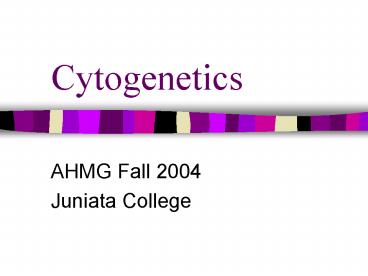Cytogenetics - PowerPoint PPT Presentation
1 / 13
Title:
Cytogenetics
Description:
1956: 46 chromosomes in human cells. First karyotype ... Analyze with light microscopy and photograph for karyotype preparation ... – PowerPoint PPT presentation
Number of Views:1238
Avg rating:3.0/5.0
Title: Cytogenetics
1
Cytogenetics
- AHMG Fall 2004
- Juniata College
2
History
- 1890-1920 techniques of plant and insect cell
staining applied to human cells - 1923 XX/XY was postulated to be the
sex-determining mechanism - 1956 46 chromosomes in human cells
- First karyotype
- 1959 Lejeune Down Syndrome (extra small
chr.), Turner Syndrome, Kleinfelter Syndrome
other trisomies visualized - 1960 phytohemoglutanin (PHA)stimulates blood
cells to divide - When they divide, they condense to we can see
them better
3
History
- 1970 chromosome banding
- 1977 high resolution banding
- 1986 fluorescence in situ hybridization (FISH)
4
Cell culture
- Types of cells that can be cultured for
chromosome analysis - Peripheral blood lymphocytes
- Amniocytes
- Chorionic villi
- Bone marrow
- Fibroblasts
- Tumors
5
Preparing a karyotype
- Grow cells in culture (mitogenic stimulation with
PHA) - Disrupt spindle formation with colemid
- Place in a hypotonic solution (lyses cells and
swells the nucleus) - Fix cells (kills them and partially extracts
histones) - Use methanol/acetic acid
- Drop fixed nuclei onto slides
- Stain (usually G-banding)
- Analyze with light microscopy and photograph for
karyotype preparation
6
G-banded chromosome 21at different resolutions
beside ideograms
7
Cytogenetics
- About 400 metaphase bands (haploid)
- About 6 million bp per band
- About 80-100 genes per band
- Can see only gross changes (about 10 genes or
more), not a single gene deletion - G-banding dark bands are AT rich, light bands
are GC rich - Centromeres are AT rich (stain darkly)
- Light regions are generally more rich with coding
sequences (promoters are GC rich)
8
(No Transcript)
9
(No Transcript)
10
(No Transcript)
11
Other cytogenetic techniques
- Fluorescence in situ hybridization (FISH)
- Spectral karyotyping
- Comparative genome hybridization (CGH)
12
FISH
13
Spectral karyotyping































